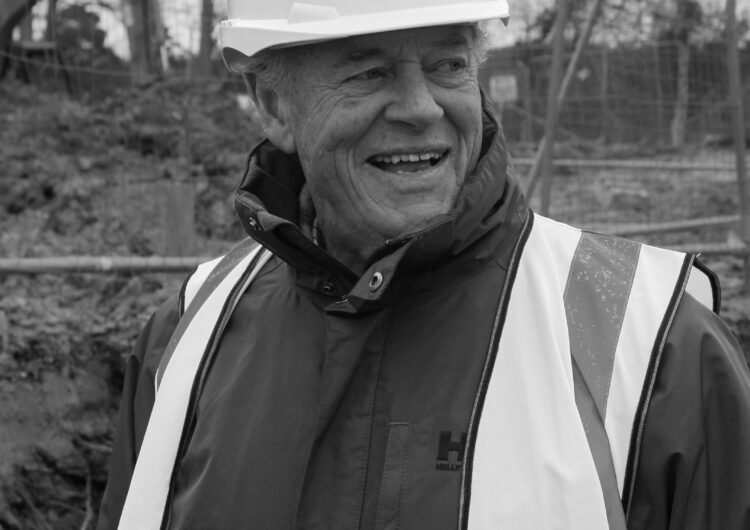
By Exec Edge Editorial Staff
In an industry increasingly driven by speed and cost-cutting, Michael Shanly stands out for his belief that housebuilding should focus on lasting value rather than quick returns. The founder of Shanly Homes — which has built more than 12,000 homes across southeast England over five decades—argues that true development is about creating places that endure and serve their communities for generations.
“Volume builders play a big part in the industry, but we all need to keep up standards—quality design, good landscaping, and communities that feel cared for,” Michael Shanly says. His perspective, rooted in years of hands-on experience, reflects a conviction that design is not a luxury but the cornerstone of sustainable development.
The Cost of Compromising on Design
Having witnessed the evolution of Britain’s housing sector since the 1960s, Shanly has seen first-hand the consequences of prioritising speed and profit over thoughtful planning: hollowed-out town centres, disconnected housing estates, and identikit developments that could be placed anywhere.
For him, treating housing purely as a commodity undermines more than aesthetics — it erodes social cohesion and weakens the sense of belonging that turns a collection of buildings into a neighbourhood.
“We spend a huge amount of time on design because it makes a scheme feel loved, especially on large housing sites,” he notes. “And we can always do better.”
That mindset, he argues, is essential in an era when developers face pressure to deliver homes rapidly to meet government targets. Too often, speed trumps vision. Yet, when design is an afterthought, the true cost emerges over time: uninspired architecture, limited public spaces, and residents who feel disconnected from their surroundings.
Good design, Shanly insists, is not a nice-to-have. It’s a necessity—a foundation for long-term value, wellbeing, and community pride. This philosophy has helped establish Shanly Homes’ reputation for quality craftsmanship, attention to detail, and context-sensitive design that complements rather than competes with its setting.
Learning from Successful Regeneration
Nowhere is Shanly’s approach more evident than in Maidenhead’s Chapel Arches regeneration, a project that has transformed the heart of the town. As part of the Partnership for the Rejuvenation of Maidenhead, Shanly oversaw a multi-phase development that introduced 270 homes, 30,000 square feet of retail space, and a revitalised network of waterways—breathing new life into the area.
“I like to do things the best we can. I still go round our sites tweaking and improving so we can be proud of what we’ve built,” he explains.
The final phase, Waterside Quarter, exemplifies this ethos. “I’m very pleased with how it turned out,” Shanly adds. “It fits in well, is maturing nicely, and the retail tenants the team selected have really helped lift the area.”
The results speak for themselves. The development now attracts nearly a million visitors annually, has earned multiple design awards, and stands as a benchmark for modern regeneration — showing that design-led thinking can stimulate both civic pride and commercial success.
The False Economy of Poor Design
A common misconception in housebuilding is that good design costs more. Shanly disagrees. “The difference between us and the big operators is that they’re all about volume; we’re more bespoke,” he says. “Our team care about the details—the materials, the gardens. It’s in our DNA.”
For him, poor design is a false economy. While cutting corners might save money upfront, it often leads to higher maintenance costs, lower property values, and long-term social issues. Developments that feel soulless or unsafe eventually require costly regeneration efforts to make them liveable again.
“Poor design is wasteful. If you build second-rate, it only gets worse. You’ve got to set the bar high and keep lifting your game,” Shanly says.
But he acknowledges the structural challenges that smaller developers face. “It’s hard for smaller housebuilders to get going nowadays—finance costs, planning delays, new taxes, endless red tape. Planning should be about striving for excellent design, but too often it’s just box ticking, with design playing second fiddle.”
In Shanly’s view, the planning system needs reform to reward quality and innovation rather than compliance alone. “When design is seen as a checklist item rather than a creative process, we end up with uniformity instead of character,” he warns.
Design as Community Building
For Shanly, design isn’t just about façades—it’s about community building. Homes, he says, are the foundations of neighbourhood life, and the spaces between them are just as important as the structures themselves.
“We always try to pick up local architectural features to help developments fit in. Other times we may go bold if we’re transforming an area,” he explains. “It’s vital to design and build well—it creates safe areas where people live and get on together. Waking up to nice surroundings makes a huge difference to how people feel.”
This belief in the emotional and social impact of design is reflected across Shanly Homes’ portfolio, from small village infill projects to large-scale mixed-use developments. The company’s schemes often incorporate green spaces, pedestrian-friendly layouts, and natural materials that give residents a sense of place.
A Blueprint for the Future
As the UK pursues ambitious housing targets to address chronic shortages, the tension between quantity and quality looms large. Yet Shanly believes the two goals need not conflict.
“Well-designed housing can be delivered efficiently while enriching communities,” he argues. “The key is seeing design as a fundamental part of planning.”
That means rethinking how developments integrate with existing neighbourhoods, support local economies, and enhance the social fabric that keeps communities thriving. “If we get the design right from the start—layouts, materials, landscaping—we can build more homes without repeating the mistakes of the past,” he says.
With over fifty years in the business, Shanly’s outlook remains refreshingly optimistic. He sees the next generation of housebuilders as crucial to shaping a more thoughtful, design-led industry—one that values longevity over short-term gain and people over units.
His five-decade commitment to design excellence offers a compelling case for taking the longer view. For Shanly, the future of UK housing will depend not on how fast we can build, but on how well we build—and whether the places we create today will still be cherished tomorrow.
Updated Preliminary Agenda: 5th Palm Beach CorpGov Forum Nov 5-6
Never Miss our Weekly Highlights HERE







